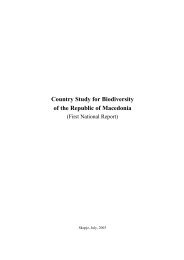English version - Convention on Biological Diversity
English version - Convention on Biological Diversity
English version - Convention on Biological Diversity
You also want an ePaper? Increase the reach of your titles
YUMPU automatically turns print PDFs into web optimized ePapers that Google loves.
Lepordae Lepus fagani Ethiopian Hare<br />
Hagos Yohannes, 2006 pers<strong>on</strong>al observati<strong>on</strong><br />
In the Buri Peninsula, there are about 66 bird species which include: Struthio camelus<br />
(Ostrich), Ardeotis arabs (Arabian bustard), Rhodoph<strong>on</strong>eus cruentus (Rosy-patched bush<br />
shrike), Merops orientalis (Little green bee eater), Anthreptes platarus metallicus (Pygmy<br />
sun bird), Trachyph<strong>on</strong>us margaritatus (Yellow-breasted), Pycn<strong>on</strong>otus barbatus, (Whitevented<br />
bulbul) etc. Most of these bird species are in a good c<strong>on</strong>diti<strong>on</strong> and are stable while<br />
some of them like the Arabian bustard are getting rare and require special c<strong>on</strong>servati<strong>on</strong><br />
attenti<strong>on</strong>.<br />
Threats<br />
The most serious bush land, grassland and wooded grassland habitats threats are:<br />
- Unc<strong>on</strong>trolled fire devastates a lot of woodland and grasslands,<br />
- Expansi<strong>on</strong> of villages and towns,<br />
- Expansi<strong>on</strong> of agriculture,<br />
- Recurrent droughts,<br />
- Invasive alien specie (Prosopis juliflora; Corvus splendens),<br />
- Illegal hunting of wildlife around Buri and Wengebo<br />
1.3.1.4 Barren Land/ Semi desert Ecosystem<br />
The barren land/semi desert ecosystem occurs in the eastern coastal plains and in some<br />
parts of the north western of Eritrea. The total area is estimated at about 47,301 km 2 ,<br />
(FAO, 1997).<br />
Status and Trend<br />
The climate in the semi desert area is so dry with very small and so erratic rainfall. Most<br />
of the land is bare and covered with sand duns. There is no recent comprehensive study<br />
c<strong>on</strong>ducted <strong>on</strong> the status of biological diversity in this particular ecosystem, but according<br />
to the biodiversity stocktaking assessment (DoE, 1999) there exist drought and salt<br />
tolerant grass species such as: Panicum turgidum, Cenchrus ciliaris Cenchrus ciliata,<br />
Leptothrium senegalens and Aristida sp., al<strong>on</strong>g with Euphorbia granulata. Tribulus<br />
l<strong>on</strong>gipetalus, Indigofera anabaptista, Indigofera spinosa, Pav<strong>on</strong>ia kotschyi, and Tephrosia<br />
sp.<br />
In the wadis, there are just a few Acacia tortilis subsp. raddiana, A. ehrenbergiana,<br />
A.nubica, Cadaba rotundifolia, Commiphora abyssinica, Tamarix aphylla), Ziziphus<br />
spina christi , Salvadora persica and Del<strong>on</strong>ix elata. The number of species, which are<br />
found in the northern part of the semi desert area of the coastal plans, clustered under<br />
different families is stated in Table-9.<br />
Table 9: Plant species (woody and n<strong>on</strong>e woody) found in the semi-desert area of the<br />
northern part of the coastal plains<br />
Family<br />
Number of<br />
Species<br />
Family<br />
Number of<br />
Species<br />
16
















